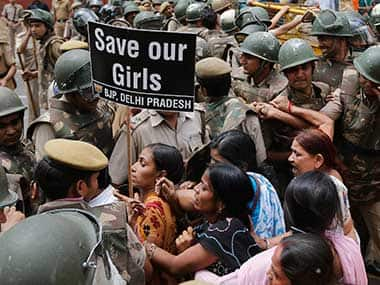As a second wave of protests hits the Capital triggered this time by the brutal rape of a five-year-old, made more shocking by the Delhi Police’s callousness in investigating it, the massive outpouring of students onto the streets witnessed in the aftermath of 16 December seems to be missing. The gangrape of a 23-year-old student and attack on her friend on 16 December had seen an unprecedented scale of protests led by students in the Capital. While the weekend witnessed protests led by left-wing student groups at India Gate and near the police headquarters, the second wave of anti-rape movement seems to have been dominated by the political parties, most visibly the Aam Aadmi Party. That it is exam season in universities seems to have had a definite impact on the numbers turning out for protests. But that is not the only reason, students say, why the scale of 16 December protest is missing this time around. [caption id=“attachment_719220” align=“alignleft” width=“380”]  BJP protesters in New Delhi against the rape of a five-year-old. Reuters[/caption] Over-politicisation, the absence of a symbol of the kind the Delhi gangrape victim represented to the youth (both as student who was like them and as a survivor who didn’t give up), being confronted with much a less talked about crime of child sexual abuse and perhaps even a sense of disenchantment with the unresponsiveness of the system, say students, could possibly explain the fewer numbers this time. The protests that the Delhi gangrape sparked, says Apoorva, a Sociology student at Delhi University, changed the public discourse on sexual crimes against women and for the first time brought on the table issues that were not publicly debated before. Apoorva, who participated in a protest at Jantar Mantar today, was among the handful of students not associated with any student union or political affiliation. The majority of students present were part of left-wing student groups such AISA, SFI and DSF. The 16 December protest, she says, was successful in moving the debate on sexual violence beyond the ‘mother-sister’ context and asserted the rights of women as individuals. The decisive direction that the 16 December protest had is missing this time, she says. “The energy has not arrived. We are still trying to gain momentum. There was so much to convey through the protest last time. A lot of students identified with what happened. That immediate connect is not there this time. We haven’t yet found the language to protest against child sexual abuse. We are grappling with what to say,” she says. However, for the left-wing student groups, who are leading and dominating the protests, there is no doubt about what the objectives of the second wave of protests are — action against cops who failed to perform their duty. Insisting that fervour of students hasn’t waned, Akbar, an MPhil student from JNU, who is member of the ultra-left student group AISA, says, “Despite exams, which is the central constraint, students turned up in large numbers at India Gate and created a traffic blockade at ITO on Sunday. I don’t think there is a lack of enthusiasm among students. The spirit is alive.” The ‘over-politicisation’ of the issue with AAP and the BJP dominating the protests in the initial days might have discouraged students from joining in, argue some. While students are more comfortable joining campaigns led by student groups or unions they feel more restricted by political parties, said one student. Sandeep, a former president of the JNU student union and currently AISA national president, says one can’t predict what shape a protest will take and why some click and others don’t. “The chemistry of a protest cannot be predicted or controlled. A moment can’t repeat itself. And every moment is new. There is a lot of anger and disenchantment. In the days to come, in another context, another protest might erupt. One can only prepare and create a platform for protest,” he says. Speaking about why the 16 December protests took on such a scale, Sandeep says, “The incident’s brutality sparked the outrage. And her spirit, she wanted to live and that created a kind of public sentiment. Every girl could identify with her.” The protests of 16 December, says Sandeeep, also injected a new energy into the student movement, which has largely remained confined to university campuses. “It changed the grammar of student politics and brought us out of our campuses.”
After the brutal rape of a five-year-old, the massive outpouring of students onto the streets witnessed in the aftermath of 16 December seems to be missing.
Advertisement
End of Article


)

)
)
)
)
)
)
)
)



